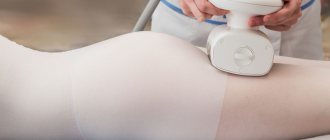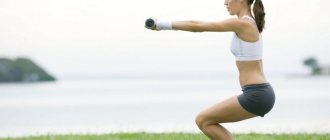Women's legs should be beautiful. But for many women, with age, the skin on their legs becomes flabby and loses its elasticity and firmness. But this problem can be fixed.
In addition to simple recommendations (nutrition, sports, fresh air, absence of bad habits), you should also seek help from a cosmetologist.
He will talk about the variety of procedures that can help with sagging skin on the legs and thighs, which one will be more suitable in your situation, how and when it is best to perform it.
Why does skin lose elasticity?
The appearance of wrinkles on the face and loss of elasticity in other parts of the body are associated with age-related changes in the skin. Epithelial cells age, begin to function incorrectly, and require external nutrition to function correctly. This process can be speeded up by:
- Poor nutrition. If you indulge in fatty, sweet, spicy and salty foods, the epidermis will not say “thank you”. All excesses are deposited in the form of fat, and acne often appears. A lack of vitamins and microelements, which a person usually gets from vegetables and fruits, makes the skin flabby and lifeless.
- Negligence towards sports. This applies to girls with a naturally good figure who believe that they do not need physical exercise at all. Such lucky women also eat everything without getting fat. The more excesses they allow themselves, believing that they have no effect on the condition of their skin and muscles, the more unpleasant it will be for them to one day find an orange peel on their butt. And if this area was pumped up, no loose skin would appear on the thighs and buttocks!
- Bad habits. Smoking and alcohol poison the body, and the skin is no exception. As a result of cigarette and alcohol abuse, the epidermis loses its tone several times faster, and its cells go crazy and work at random.
- Hormonal imbalances. You cannot blame a woman for the improper functioning of the endocrine system; you can reproach her only if she does nothing about it. Hormones are not just “oh, I started gaining weight quickly!”, it’s serious and requires the right approach, especially after 45 years.
- Sudden weight gain and loss. If a lady pulled herself together and signed up for the gym, she needs to be praised for it. And praise again if she took the issue of sagging skin seriously and bought several scrubs or creams to correct the situation.
- Bad heredity. Some girls' skin begins to sag at the age of 25; their mothers and grandmothers experienced the same sad situation. In this case, all that remains is to prevent the problem from getting worse.
Since you can't go to sleep with toned thighs and wake up with floaty thighs, a disaster can be corrected before it even occurs. The main thing is an integrated approach from different sides.
Causes of loose skin on legs
The lower body in women is the most problematic. Excess fat is deposited in the thighs and buttocks, and the skin becomes saggy. In old age, such changes are due to the natural processes of aging. But, there are a number of factors that provoke early deterioration of the dermis.
The main ones:
- bad habits;
- sudden weight changes;
- genetic predisposition;
- improper skin care;
- avitaminosis;
- pathologies of the endocrine system;
- sedentary lifestyle;
- living in a region with an unfavorable environmental situation;
- unbalanced diet;
- disturbances in hormone production;
- diseases in which metabolic processes in the body proceed incorrectly.
The appearance of the epidermis can deteriorate due to injuries, when a person is limited in movement for a long time, muscles and skin lose tone. Hips and buttocks are the most vulnerable parts of the body. They quickly sag and lose their firmness and elasticity.
But, more often than not, the skin on the butt becomes unattractive due to objective reasons. Let's take a closer look at the most common ones.
Age-related skin changes
The human body begins to age after 25 years. Cosmetic defects appear in the lower part of the body:
- folds;
- sagging;
- "Orange peel".
These changes are associated with a reduction in the synthesis of collagen and elastin. Metabolic disorders lead to the fact that fluid and fat are unevenly distributed, tubercles appear on the skin, and the epidermis becomes flabby. The problem is typical not only for overweight people, but also for those who are not overweight.
After childbirth
For women, the problem of sagging skin on the thighs and buttocks is more common. Often it is associated with the process of bearing a child. During pregnancy, hormonal and physiological changes occur in the body of the expectant mother. The dermis is greatly stretched due to sudden weight gain and swelling, and the muscles weaken.
After childbirth, sagging “extra” skin, stretch marks, and scars form on the body. The resulting cavities are filled with adipose tissue. The covers become loose and flabby.
As strange as it may seem, thin girls who did not exercise before pregnancy suffer the most from this problem.
After losing weight
In an effort to quickly lose excess weight, women often get carried away with various mono-diets. Such eating behavior gives a very dubious result. The body is deprived of vitamins and microelements necessary for normal functioning. The skin becomes dull, turns gray, and dries out.
In addition, due to a sharp change in the structure of the fat layer, the dermis does not have time to contract, becomes flabby, and sag in unsightly folds.
In children
This problem is not typical for children. Folds on a child’s hips are caused by:
- genetics;
- “sedentary” lifestyle;
- failure to comply with hygiene rules;
- endocrine pathologies;
- constant consumption of junk food.
Another cause of sagging skin on the lower extremities in children is lack of body weight. Hypotrophy negatively affects the immune system, leading to a partial loss of absorption of nutrients and vitamin deficiency. The layer of subcutaneous fat thins, the epidermis dries out, and gathers in folds.
It is possible to restore attractiveness to your legs and buttocks, but this will require some effort.
Basics of working on yourself
In order for the result to be as effective as possible, and for sagging skin on the thighs and buttocks to stop annoying by the very fact of its existence, we are preparing for a long and difficult war against imperfections. Heavy artillery to keep yourself in good shape consists of:
- cosmetic wraps;
- a variety of home treatments;
- use of creams;
- sports exercises to pump the inner and outer thighs;
- proper nutrition.
In some particularly advanced cases, plastic correction may be required, but it is highly not recommended to resort to it without trying a set of these 5 methods. The fact is that the surgeon will cut off the excess flesh, but the muscles and skin will not learn to maintain themselves in good shape, and six months to a year after the surgical intervention the problem will manifest itself again.
Treatment
The treatment method for hyperkeratosis depends on the form of the disease and the cause that caused it. As a rule, during periods of exacerbation, local use of corticosteroid ointments is indicated, which relieve inflammation and exfoliate dead skin. Mild acid peeling with the help of special creams helps to get rid of hardened layers of skin. Mechanical removal of hardened areas is not recommended, as this may increase the formation of the stratum corneum. Warm baths with the addition of salt, baking soda or starch, after which a moisturizer is applied to the skin, have a good effect.
Hyperkeratosis of the scalp is treated with softening compresses, for which castor oil, petroleum jelly or glycerin, fish oil, etc. are used. If necessary, ointments containing hormones can be prescribed. In the follicular form of the disease, external treatment of the stump is of great benefit, so therapy is aimed at eliminating disturbances in the functioning of the body.
In case of hyperkeratosis of the skin of the feet, it is necessary to first eliminate the factor causing the pathology. Often the pathological factor is a skin fungus, which is treated with special antifungal ointments. A good effect is achieved by warm foot baths with table salt, after which the steamed stratum corneum is removed using pumice, and the skin is lubricated with a softening cream. It is necessary to choose comfortable shoes that do not squeeze or rub the foot. If the patient suffers from clubfoot or flat feet, care should be taken to choose special shoes.
Cosmetic wraps
A very pleasant procedure will help tighten the skin on your legs and get rid of sagging. It will only help if used regularly and combined with sports exercises. You can go to a salon for this purpose, or you can prepare the mixture at home. Since wraps increase body temperature in the treated areas, harmful substances are released from the epidermis and dermis, lymph and blood flow accelerates, and nutrients enter the heated tissues faster. Cellulite disappears, the fat layer gradually dissolves, and the legs look slimmer.
Cosmetologists confirm that some common products that we see on the dinner table every day can improve the quality of the skin and restore its youth.
For the procedure it is recommended to choose:
- honey, which can be mixed with egg yolk, milk or dry kelp soaked for 15 minutes;
- olive oil, to which you can add a few drops of another essential oil;
- apple cider vinegar, which must be diluted with the same amount of water; concentrated liquid will cause a burn;
- green tea, the leaves of which are ground and mixed with water to form a slurry;
- clay, which can be purchased at any pharmacy or cosmetic store, must be diluted with water to a paste.
The sequence of the wrapping procedure is as follows:
- We take a hot shower so that the pores open and are ready to receive a shock dose of nutrients.
- Thoroughly rub the inner and outer surface of the thigh and butt with a body scrub to remove keratinized particles of the epithelium. You can buy it ready-made in the store, or you can mix it yourself. The following combinations are considered the best: coffee grounds + honey (for sensitive skin it is better to replace honey with cream), coarse salt + honey, oatmeal + honey; sugar + olive oil.
- Apply a thick layer of the pre-prepared mixture of the ingredients given above.
- We begin to cover the leg with cling film; you need to move in a spiral from the knee and above.
- We put on warm pants, tights or just wrap ourselves in a blanket. We lie like this for half an hour.
- We take a shower (contrast shower is possible) and apply a moisturizer to our feet, preferably with an anti-cellulite effect.
To combat cellulite and sagging, it is recommended to do hot wraps; they tone the skin more effectively. For maximum effect, you need to repeat the procedure at least once a week, as often as possible.
Another wrapping mixture recipe (video):
Home treatments
To tighten problem areas and get rid of cellulite, it is not necessary to run to a cosmetologist; most procedures can be easily performed independently at home. The following will help make your skin soft and toned:
- massage;
- bath;
- cold and hot shower;
- salt baths.
Let's look at the procedures individually and figure out why they work.
Massage
The process of massaging the skin is easy and pleasant. If you have a special massager, you can do it yourself. Anti-cellulite massage accelerates blood flow, as a result of which the cells receive increased nutrition and begin to renew themselves. The skin is toned and becomes more elastic, the orange peel on the outer thigh gradually disappears.
The most popular massage techniques are:
- Anti-cellulite. You can’t do without an assistant here, since it’s problematic to completely work out all the problem areas on your own. Before massaging, you need to apply a base oil or cream to the skin. It is necessary to begin the procedure with soft stroking movements, gradually increasing the pressure. It may hurt, but only in this case can you expect the maximum effect. You need to move from the knees to the groin area, the skin needs to be rubbed, pinched and twisted, it would be a good idea to knock on it with your fists. If after the procedure the surface of the legs turns pink and burns, then everything was done correctly. But under no circumstances should there be bruises!
- Honey. An interesting massage technique for smoothing sagging skin. You need to apply a layer of honey to the dry skin of the problem area, then stick your palm to it and jerk it off. The sensation is “magical”, very similar to waxing. Despite the pain, it helps to tone the skin and draw out toxins. The beneficial substances contained in honey quickly penetrate the epidermis and dermis, deeply nourishing the skin.
- Canned. For the procedure, you will need special silicone cups that stick to the skin and thereby give the flabby skin the necessary “shake-up”. We move, as in the case of anti-cellulite massage, from bottom to top, avoiding the inner surface of the legs. Excessive vacuum should not be created, as this will lead to bruising.
The easiest way to massage your legs and remove sagging is to buy a special massager. They are usually produced in the form of rollers with small needles that tingle pleasantly and do not injure. For best results, you can apply a thin layer of base oil to the inner and upper thighs, to which a few drops of ether are added.
Bath and contrast shower
Every Russian person is genetically predisposed to visiting a bathhouse, and if you combine business with pleasure and take skin care products to the steam room, the effect will be unsurpassed. The steamed epidermis is ready to absorb several times more nutrients than if skincare cosmetics were applied at home in the bathroom. You can steam yourself with a broom, then you won’t need to do an additional massage.
Procedures with temperature contrast are no less beneficial for the overall health of the body and skin. After the steam room, it’s a good idea to quickly plunge into a cool pool or run outside. This shock therapy stimulates the renewal of skin cells, which “fall asleep” without regular shocks.
If it is not possible to go to the bathhouse, you can take a contrast shower. The temperature must first be changed gradually so that the body gets used to it, then more abruptly. Changing hot water to cold water speeds up blood flow, and with good blood supply, the skin will sag much more slowly (if at all!).
Salt baths
Cosmetologists say that cellulite is afraid of salt! A weak saline solution softens and tightens sagging skin, nourishes it with energy and stimulates collagen production. To carry out the procedure, you only need warm water and salt. For a regular bath you will need about half a kg of salt, which must be thoroughly dissolved. You need to lie in a salt bath for about 15-20 minutes, the muscles should be relaxed and the body should be completely immersed in water. After this, you need to take a shower, you can rub your body with a scrub. After washing off the scrub or shower gel, wipe yourself dry and apply a nourishing cream.
Every day we experience enormous stress: we walk, run, play sports. In the evening, we take off our shoes with difficulty, overcoming the heaviness and pain in our feet, crawl to the sofa and swear to ourselves that from tomorrow everything will be different! We will definitely learn how to take care of our feet: we will read on the Internet, seek advice from a specialist and will certainly strictly follow all recommendations. But tomorrow comes - and again we need to go somewhere, run, go. Meanwhile, your legs can remind you of themselves in very unpleasant ways. If calluses and loose skin spoil only the aesthetic impression, then varicose veins are a serious disease. But how can you distinguish fatigue from illness and properly help your legs? We were consulted by an orthopedic doctor at the MAMME clinic, Vladimir Aleksandrovich Kapranchuk. He talked about the most common myths associated with leg pain and gave effective recommendations for the treatment and prevention of varicose veins.
So, our quick survey:
1) There is an opinion that with the onset of autumn cold, the knee joints will hurt and the best way to treat them is iodine mesh. Is it so?
— There is some truth in this. Indeed, most joint diseases, such as osteoarthritis, often worsen in spring and autumn. But the iodine network is unlikely to help here. It is better to apply anti-inflammatory or locally irritating gels, ointments, use dry heat, various kinds of compresses that relieve swelling and inflammation, and during loads, use special braces on the joints. You should not get carried away with self-medication; it is better to coordinate everything with a specialist (orthopedist or rheumatologist).
2) Many women are sure that the best shoes for maintaining health are ballet flats (if we take it more broadly, any shoes with flat soles). During pregnancy, you can only wear these shoes. Is their statement true?
- No, this is a wrong opinion. Shoes should not have flat soles, but the heel will not bring any benefit either; the optimal shoes for proper distribution of loads in the feet are shoes with a platform (“wedge”), with a heel height of 4-6 cm. Also, shoes should not be very narrow or, conversely, wide. Incorrectly selected shoes can lead to the formation of so-called transverse flat feet, which, in turn, leads to the formation of deformation of the first toe - the so-called “bunion”. It is especially important to pay attention to the correct selection of shoes during pregnancy, because... During this period, the load on the feet increases.
3) There is an opinion that in case of a dislocation or bruise, it is enough to apply cold to the sore spot, and everything will go away. Such injuries are rarely treated by an orthopedic surgeon. Is it correct?
- This is partly true. Cold therapy is certainly the first and main thing that can be done at home. Usually it is recommended to apply an ice pack or a cold pack to the site of a bruise or hematoma, always through the tissue for 15-20 minutes, then a break of 1 hour, then cold again and so on for 4-6 approaches in the first day or two. In some cases, cold therapy is relevant for up to 7-10 days. On the other hand, patients often cannot objectively assess the severity of the injury. Therefore, we recommend that in almost all cases you go to the emergency room for examination by a specialist. In some cases, a modern examination may be needed, such as an MRI (magnetic resonance imaging).
4) There is a widespread belief that athletics are the most effective for maintaining good physical shape, and this sport is suitable for everyone without exception. Is it so?
- No. When choosing physical activity, much depends on age, health, physical condition, etc. Athletics are not recommended for patients with arthrosis of the knee and hip joints. The optimal sports for such patients are swimming and cycling.
5) Many women are convinced that if at the end of the working day their legs are swollen, a feeling of fatigue and pain appears - the best remedy to alleviate this condition is a hot bath. What is the doctor's opinion?
- This is also incorrect. Legs swell mainly due to muscle insufficiency of the vein walls. This may be due to genetic predisposition, excess body weight, or poor physical activity. On the other hand, the cause of leg swelling can be flat feet or kidney problems. Therefore, you definitely cannot do without consultations with specialists - angiosurgeon (phlebologist), orthopedist.
6) Osteochondrosis is a disease of a “sedentary” lifestyle. Many people believe that it is impossible to get rid of it, and that their condition can only be alleviated with the help of a strong painkiller. Is it so?
- Also incorrect. An important part of the treatment of osteochondrosis is physical education and sports, physical therapy aimed at strengthening the muscular “corset” that supports the spinal column. Special types of massage, underwater traction, physiotherapy, and acupuncture are often prescribed.
7) It is generally accepted that arthrosis develops in older people. The main cause of arthrosis is the consumption of large amounts of salt. Is this statement true?
- This is wrong. The first signs of osteoarthritis appear in women aged 37-40, in men - usually a little later. This disease also has nothing to do with salt deposition. The main theory for the development of arthrosis today is genetic, when a special gene responsible for the structure of cartilage is inherited, which begins to manifest itself under various predisposing factors - excess body weight, work “on the legs”, active sports with chronic microtraumatization, the presence of dysplasia (underdevelopment ) joint, flat feet, previous operations on the joint - for example, meniscectomy in the knee joint, previous intra-articular fracture, etc.
As you can see, foot health is a serious matter. Any ailment - from minor bruises to chronic diseases - must be treated carefully, choose the right treatment and do not forget about prevention. If you “take your feet in your hands” in time, your gait will remain light for many years, and your step through life will remain confident.
Anti-cellulite creams
The shelves of stores and pharmacies are overflowing with anti-cellulite products, each of which literally begs you to buy it, promising a magical effect in just three days. The following creams for tightening sagging skin are considered the most effective:
Anti-Capiton (Clarins)
Celluli Eraser (Biotherm)
Phyto-Svelt Global (Sisley Paris)
Aqua Destock (VICHY)
- Anti-Capiton (Clarins) - contains extracts of 6 herbs that improve blood circulation and intracellular metabolism, heal microcracks and make the epithelium smoother and more elastic.
- Celluli Eraser (Biotherm) , as the name says, erases sagging and cellulite like an eraser. The main active component of the cosmetic product is coral algae extract, which helps to dissolve the fat layer, as well as ginkgo biloba extract and salicylic acid, which have a gentle exfoliating and disinfecting effect.
- Phyto-Svelt Global (Sisley Paris) contains plant extracts that prevent water from accumulating in tissues and prevent the formation of fat layers.
- AquaDestock (VICHY) has a complex effect on two fronts: it prevents water from retaining in the skin and at the same time smoothes out sagging epidermis.
The list of good anti-cellulite products is much longer and, if desired, you can choose a product for any type of epithelium and wallet size. It is advisable to choose products with a targeted effect; if you chase several birds with one stone and buy “10 in 1” cosmetics, then there is a high risk of not getting any positive effect at all.
Physical exercise
Sports are the basis for firm skin. Until a woman understands this, her butt and all sides of her thighs will remain flabby. Experienced trainers have developed entire complexes to work out the most cellulite parts of the female body. Here are some of the exercises:
- We put our feet wider, our hands in front of us, and begin to squat. The ideal final position is that your thighs are parallel to the floor, your knees do not extend forward beyond the tips of your toes, and your butt is pushed back.
- We stand sideways on a regular staircase, holding the railing with our hands. Place your left foot on the first step, your right foot on the second so that your legs are crossed. We go up one step, cross our legs again, so we need to go up one floor. After this, we turn in the other direction, the right foot on the first step, the left on the second. We go up one more floor.
- We lie on our sides and stretch out. We bend the upper leg at the knee and begin to lift it up as slowly as possible until it stops. Tension should be felt in the outer thigh and butt.
Additional exercises - on video:
https://www.youtube.com/watch?v=33d1HXvrsOM
Regular training allows you to round and tighten your legs; if you do not neglect sports, loose skin on your thighs will be forgotten like a bad dream.
Proper nutrition
In the era of fast food and genetically modified food, it is vital to adjust your diet so that you get most of the vitamins and microelements not from pharmacy vitamin complexes, but from food. Delicious diet dishes will help you lose weight and stay fit.
The daily diet should be based on the following principles:
- You need to drink at least one and a half liters of water. A large amount of fluid entering the body will help the flabby epithelium become more elastic and pliable, responding well to massage and cosmetics. Remember that clean drinking water cannot be replaced with tea, coffee or carbonated drinks; they are not included in the required daily one and a half to two liters.
- Increase the amount of protein in your diet. According to research, for normal functioning the body needs 2 grams of the substance per 1 kg of weight daily. Protein is the “building blocks” of our body, and without it, sagging skin will not be able to renew and tighten. The vital substance is found in meat, fish, legumes and dairy products.
- To maintain energy, carbohydrates are required, which can be fast and slow. Give up the fast ones found in sweets and baked goods, and switch to slow ones. Eat pasta, cereals, natural honey.
- To maintain the elasticity of flabby skin, collagen is needed, which can be produced in the body in insufficient quantities. It should be taken from seaweed, fish, fruits and vegetables.
- Eat foods with natural antioxidants and fatty acids. Flaxseed oil, nuts, beans, and cranberries will help maintain beauty and tone.
Try to get rid of the habit of eating at night; if you really want to have a snack before bed, drink a glass of kefir or nibble on an apple. It is advisable to establish a diet and have breakfast, lunch and dinner at the same time. This way, the body will get used to receiving food at certain hours and will not require snacks. Don't overeat, it's better to eat 5 small portions throughout the day than 3 large ones.
What causes sagging skin
Before we start putting our body in order, let's look at the causes of sagging. This problem may arise due to the following factors:
1. Losing weight too quickly. When a person goes on strict diets, he rapidly loses weight. As a result, not only fat, but also muscle is lost. Always remember that the norm for losing weight is approximately 1 kg per week.
2. Apple body type. This feature is characterized by excess weight in the upper body. The legs in this case are not a problem area, but the area below the shoulders can become flabby, as a result of which we see sagging arms. However, the situation can be corrected through special exercises.
3. Excess of ultraviolet radiation. If you often sunbathe on the beach or in a solarium, neglecting sunscreen, the skin becomes dry and dehydrated, which leads to sagging and loss of elasticity.
4. Incorrect posture. The spine is the frame of our figure. If your back is constantly hunched, then other parts of the body suffer, not just the arms and legs. With incorrect posture, a double chin and swelling on the face may appear.
5. Bags are too heavy. Many people think that carrying weights is good for strengthening muscles. But this is a big misconception, since in this case the body only wears out. Due to the contracted position of the muscles, they become sluggish, as a result of which the skin also suffers.
Salon treatments
If your income allows, you can turn to specialists who can help you get your sagging skin in order. Depending on the extent of the problem, cosmetologists can offer the following procedures:
- mesotherapy, in which subcutaneous injections of special substances are made that nourish the skin layers and improve metabolism in cells;
- biorevitalization, which involves “driving” hyaluronic acid under the skin using a special laser;
- vacuum roller massage, which accelerates blood and improves cell nutrition;
- RF lifting, based on heating tissue using radio waves;
- hydromassage, literally breaking up the fat layer and toning sagging skin.
The specialist will determine the duration of the course and the necessary set of procedures, but the effect will be long-lasting only with sports exercises, proper nutrition and cosmetic procedures.
Reasons for the development of pathology
All causes of keratosis development can be divided into two groups. The first includes external influences - tight shoes or clothing that rubs certain areas of the skin, intense physical labor, constant contact with chemicals or other substances that negatively affect the skin, failure to comply with hygiene rules, etc.
The second group includes diseases and pathological conditions that lead to excessive formation of the stratum corneum:
- systemic disorders, congenital or acquired - ichthyosis, diabetes mellitus, psoriasis, keratoderma, etc.;
- circulatory disorders, most often occurring in the lower extremities - varicose veins, obliterating atherosclerosis;
- lack of vitamins;
- fungal diseases of the skin (lichen) and feet;
- gastrointestinal diseases;
- stress;
- excess weight, foot pathologies, lameness.
Under the influence of certain factors in the upper layer of the skin, capillary blood supply is disrupted and innervation worsens. Because of this, the process of cell division in the stratum corneum is activated, with a simultaneous slowdown in their desquamation and the formation of thickened keratinized areas.
Surgical intervention
You can resort to the help of a surgeon only in extreme cases, for example, if a woman weighed 130 kg and lost weight to 70. The remaining flabby skin gathers in folds and significantly interferes with life. In general, the tightening procedure is simple and is not accompanied by complications. The rehabilitation period lasts from 2 to 4 months.
There are the following types of surgical lift:
- On the inner thigh. With this type of intervention, two long incisions are made from the knee to the groin area. This method is effective if you need to remove a large amount of loose skin. The spiral lift helps shape beautiful thighs; it is usually used for people after extreme weight loss, when huge folds of skin remain. More often, a combined technique is used, in which the effect is carried out on certain problem areas.
- Butt lift using implants. During the operation, an incision is made in the hollow between the buttocks, and an implant is inserted through it. Surgery is performed under general anesthesia, rehabilitation lasts 3-6 months. This type of lift is beneficial because you can literally form new buttocks and get rid of loose skin.
- Butt lift without implants. The operation is performed in the same way as a thigh lift, and recovery only takes a couple of months. But it is important to take into account that a lift without implants will only remove sagging; you will have to form the roundness yourself in the gym.
- Brazilian lift. One of the most painless surgical interventions is based on the introduction of gold, platinum or Teflon threads under the skin, which hold the tissue of the buttocks and prevent them from sagging.
Despite the quick and excellent effect, doctors do not recommend undergoing surgery without proper reason. Try sports, proper nutrition and salon treatments first.
Prevention of sagging
It is much easier to prevent a problem from occurring in the first place than to frantically look for ways to get rid of it later. There are the following measures to prevent the appearance of loose skin:
- Exercise regularly. Even five minutes of training with emphasis on the hips and buttocks will keep the muscles toned and not sagging.
- Eat right. If your diet contains a lot of protein and collagen, and unhealthy fast food fades into the background, the orange peel will not even think of appearing.
- Keep an eye on the epithelium and moisturize it on time. Dry skin will wrinkle and begin to sag faster than healthy and moisturized skin.
The rules of prevention are simple; regularly following these simple recommendations will allow you to never know what cellulite and loss of elasticity are.
Prevention
To prevent the re-development of hyperkeratosis, it is necessary to care for the skin, ensure its nutrition and hygiene. The following will help prevent relapses of the disease:
- normalization of nutrition, provision of a varied, balanced diet;
- avoidance of prolonged exposure to the sun or hypothermia of the skin;
- hygiene, skin care;
- use of protective equipment when working with chemical reagents.
Some forms of the disease are extremely difficult to treat and remain with a person throughout his life. In this case, it is especially important to pay attention to preventive measures that reduce the risk of relapse.









